
|
|
|
|
Odd Things in Wrong Places.
As man digs and scrapes and drills into the mysterious earth, many surprising finds are made. It follows that mining and farming have been fruitful sources of curious finds in the past. We can feel strong regrets that as both occupations have become more and more mechanized, fewer and fewer finds of value for scientific study will occur. The following interesting items make two important points. If conventional dating is followed, ancient man seems to be far more ancient than he should be. In fact, he must have been thriving before he is supposed to have evolved. Second, ancient man was a very sophisticated person. There is no indication that his brain gradually evolved. Both of these conclusions, obviously, are completely opposite to evolutionary theory.
One of the most prodigious lava flow in the history of the world occurred
in the Pacific Northwest. The lava spread over an estimated 200,000 square
miles in depths up to 5,000 feet. In 1972, a competent geologist stated
that the eruptions took place a mere fifteen million years ago. Much of
Washington, Oregon, Idaho, and portions of neighboring states, was covered.
The immense age of the deposit can easily be imagined by the fact that
the Snake River has cut canyons through the deposit to depths of up to
3000 feet.
| Still, there are several curious things about this lava flow. Many competent observers have commented on the remarkable freshness of the deposit, as though the eruptions took place in very recent times. A startling find was made in 1889 near Nampa, Idaho. While workers were boring an artesian well, a small figurine of baked clay was extracted from a depth of 320 feet. Above the figurine, the drill, inside a 6-inch tubing, had cut through fifteen feet of basalt lava and many other strata. The find has never been challenged except to say that it was impossible. The conclusion is unmistakable. Before the basalt flowed, sophisticated humans lived in the area (Velikovsky, 1955, p.87; Pensee , May 1972, 2:2, p.18). Ancient men lived in California. They worked the hardest stones, fabricated perfect granite mortars and dishes, used a circular, skillet-like vessel made of lava, hard as iron, which had three legs and a spout, made polished stone axes with perfect holes drilled in them for a handle, and fashioned ladles, disks or quoits. They were able to bore into the bowels of mountains for gold and silver. |  |
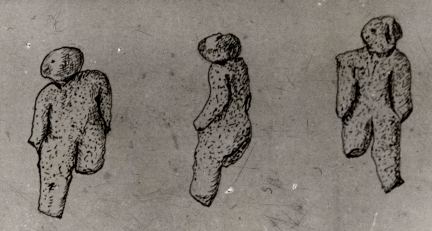
One ancient shaft was drilled 210 feet down into solid rock. An altar for worship was found there. Other finds include the following: a mortar for grinding gold ore at a depth of 300 feet in a mining tunnel, a mortar and pestle weighing 30 pounds, beads, perforated stones, a 40-pound oval granite dish. One human skull was found at a depth of 130 feet under five beds of lava and tufa separated by layers of gravel. Man came before the lava flowed, and deep canyons have been cut by rivers since the lava spread. An amazing number of stone relics have been found. The finding are almost always in gold-bearing rock or gravels (Victoria Institute , 1879, 15:193-198).
A California newspaper reported the find of an elaborately carved rock and other worked stones weighing up to 800 pounds which had been found in hydraulic operations hundreds of feet underground. The original site was an ancient river bed dated long before the last Ice Age (Edward, 1964, p.109).
Nothing describes what has been discovered in California quite as well as Job 28 (TEV). Similar locations have been studied in many parts of the world. Read this detailed and sophisticated memory of what mining in ancient times was like.
Far from where anyone lives or human feet ever travel, men dig the shafts of mines. There they work in loneliness, clinging to ropes in the pits. There are mines where silver is dug. There are places where gold is refined. Men dig iron out of the ground and melt copper out of the stones. Men explore the deepest darkness. They search the depths of the earth and dig for rocks in the darkness. Food grows out of the earth, but underneath the same earth all is torn up and crushed. The stones of the earth contain sapphires, and the dust contains gold. No hawk sees the roads to the mines, and no vulture ever flies over them. No lion or other fierce beast ever travels those lonely roads. Men dig the hardest rocks, dig mountains away at their base. As they tunnel through the rock, they discover precious stones. They dig to the sources of rivers and bring to light what is hidden. The value of wisdom is more than coral, or crystal, or rubies, or the finest topaz and the purest gold.
| In the museum at Moses Lake, Washington, are some very crude scrapers on exhibit which were found under a glacial morain. This would appear to date man in Washington to a time before the Pleistocene epoch, which scientists are reluctant to do. A similar discovery was made near Sudbury, Ontario, Canada. Crude choppers and scrapers of quartzite were found deep in the earth and had been tumbled and mixed in glacial till. Again this is evidence that man lived there before the glacial advance. Scientists do not want to put man in America that long ago (Folsom, 1971, p.70; p.184). Such finds are no problem for creationists who see no conflict for such finds within a biblical time framework. | 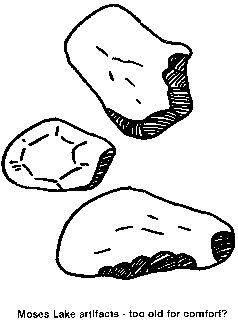 |
In 1871 near Chillicothe, Illinois, well drillers brought up a bronze coin from a depth of 114 feet. This remarkable discovery was described in the Proceedings of the American Philosophic Society . This is additional evidence that man had been present there. Rapid change of the terrain is also indicated (Edwards, 1962, p.101).
Heizer notes a number of impossibilities according to commonly accepted
geological dating: a hyena tooth sawed by a flint before it became fossilized,
cutting operations on the fossilized bone of an extinct rhinoceros and
on other animals at a site near Paris, and evidence of the use of a sharp
tool on the horn of fossilized rhino remains in Ireland. Under the surface
of the North Sea the trunk of an oak was removed from a long submerged
forest. The trunk showed the marks of a hatchet on it. (Heizer, 1962, p.107-114).
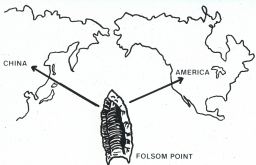
Should "age" depend on where you find it? |
Conventional theory has early hunters migrating from Asia to America. One of the best known early projectile points is the Folsom point, and the identical pattern is found both in China and over much of America. It is of particular interest that this point is dated as early as 10,000 B.C. in America, but no earlier than 2000 B.C. in China (Mertz, 1972, p.99). Theory, however, requires the points in China to be older. |
| In 1885 at a foundry belonging to Isidor Braun of Vocklabruck, Austria, a block of coal was broken up. Out of it fell a small iron or steel cube with a deep incision around it and with the edges rounded on two faces. Some who examined it concluded that only human hands could have made the object. The son of the owner later took it to the Linz Museum in Austria, but later it was lost. A cast of the cube, however, is still kept by the museum. | 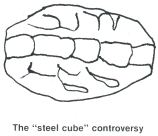 |
The debate was never closed. One authority in 1886 held it to be an
iron meteorite. Unfortunately there is no longer a way to verify that the
object was actually encased in brown coal. Some hold that it is merely
a cast iron object which may have originated in the foundry where it was
discovered (Thomas, 1971, p.28-29).
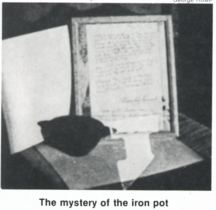 |
In 1912, some coal mined near Wilburton, Oklahoma, revealed a mystery which has still not been solved. Two employees of the Municipal Electric Plant, Thomas, Oklahoma, came upon a solid chunk of coal too large for the furnace. They broke it up with a sledge. An iron pot fell from the center where it had left an impression or mold in the piece of coal. An affidavit was made out by the two witnesses, and the pot was photographed. Many persons examined this strange object. |
The proceedings of a society of antiquities, Scotland, reported a similar strange discovery. An iron instrument had been found in the heart of a piece of coal from a mine in Scotland. The instrument was considered to be modern, but there was no sign of boring in the piece of coal.
Some years ago Henry Morris reported that he had interviewed a coal miner in West Virginia who had excavated a perfectly formed human leg turned into coal. Years before in the same general area another party of miners unearthed a well-constructed concrete building. Not enough information exists to evaluate these supposed finds (CRSQ , 1970, 7:4, p.201; 1968, 5:4, p.147; Fort, 1941, p.127-128).
In the collection of the Freiberg Mining Academy, Germany, was an object supposed to be a fossilized human skull in brown coal, first described in 1842, before Darwin's book on the origin of species. The specific source of the 'skull' is unknown. While the object is frequently labeled as a fake, the early date of its description is in its favor. A scientist in Germany referred to it as a puzzling human skull a few decades ago. The matter is still an open question, but the problem is that it was found in a formation too old for it by conventional dating assumptions (CRSQ , 1968, 5:4, p.132).
Other strange things have been reported found in rocks. For example, a nail was reported by David Brewster in a sandstone block from the Mesozoic Era. Another report indicates that it was discovered in Old Red Sandstone of Devonian age. In a report of the British Association, 1845-1851, it was stated that a nail was found in a block of stone from the Kingoodie Quarry, Scotland. The block was nine inches thick and came from below the surface. The point of the nail projected into some till and was quite eaten with rust, but the last inch, including the head, was embedded in the stone (Charroux, 1970, p.181); Fort, 1941, p.131).
Workmen quarrying rock near Tweed below Rutherford Mills discovered a gold thread embedded in stone at a depth of eight feet. A piece of this object was sent to the office of the Kelso Chronicle in that district (Fort, 1941, p.130).
A report was carried in Scientific American that in June, 1851,
workmen were blasting near Dorchester, Massachusetts. Cast out from a bed
of solid rock was a bell-shaped metal vessel. A photo of the vessel, with
inlaid floral designs in silver, showed a remarkably high degree of craftsmanship
(Fort, 1941, p.128).
In the sixteenth century, Spanish conquistadors came across an iron
nail about six inches long solidly encrusted in rock in a Peruvian mine.
The rock was estimated to be tens of thousands of years old. Iron was unknown
to the Indians there. The Spanish Viceroy kept the mysterious nail in his
study as a souvenir, and the account of this find was recorded by letter
in the Madrid Archives, 1572. Another odd report in the London Times
, 1851, stated that Hiram de Witt found a piece of gold-bearing quartz
in California. When it was accidentally dropped, an iron nail with a perfect
head was found inside (Thomas, 1971, p.29).
Many of these curious reports cannot be verified to our satisfaction today. The reports seem to this observer, however, to be too varied and widespread to be nothing but hoaxes. In this section again, we see many reasons to respect the sophistication of men who lived long ago. The concept of a young earth here too fits well with the kind of finds that have been made.